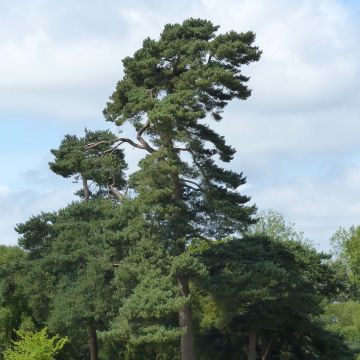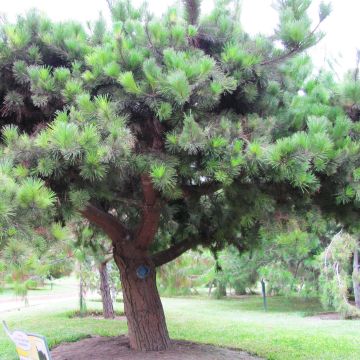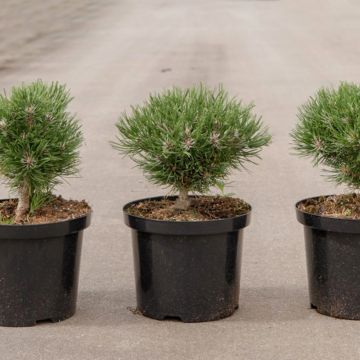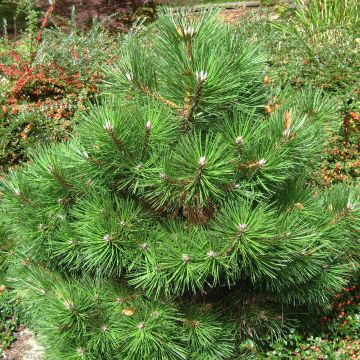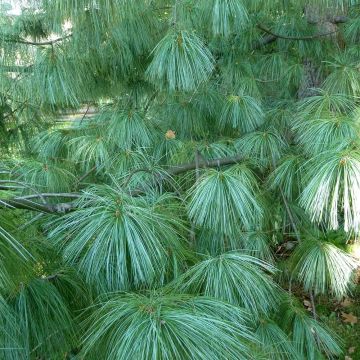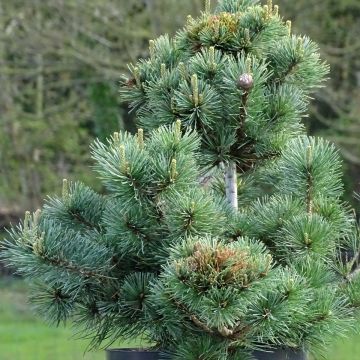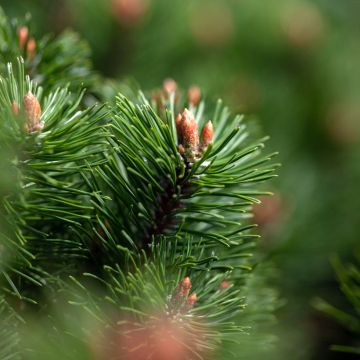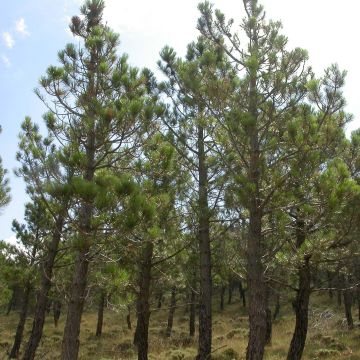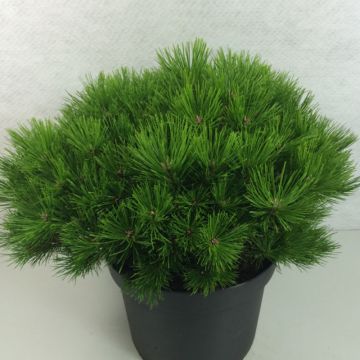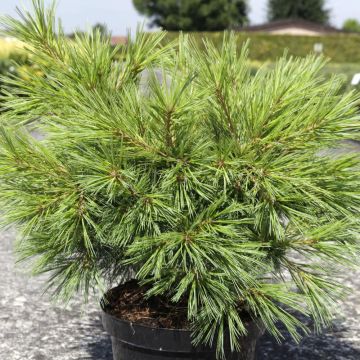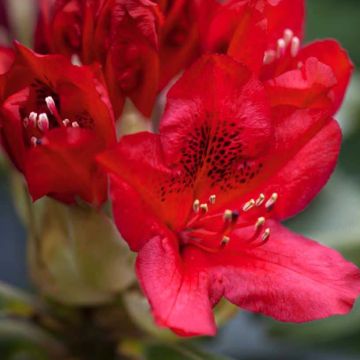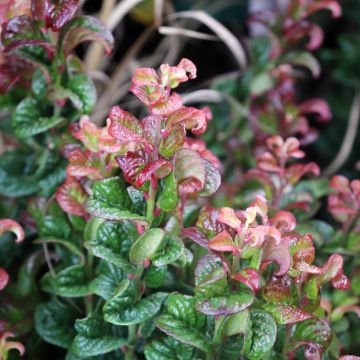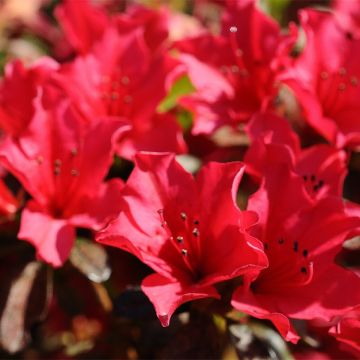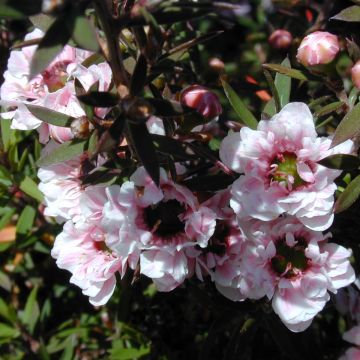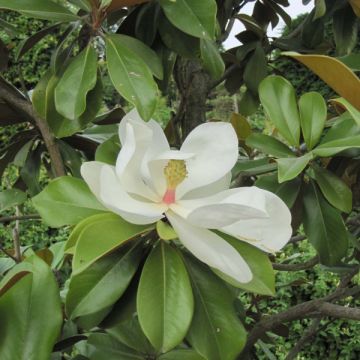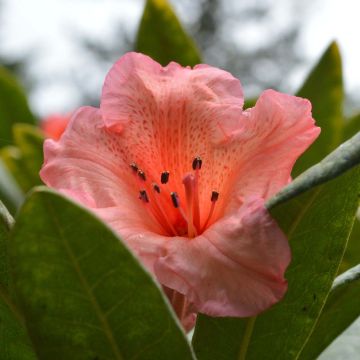

Pinus densiflora Oculus-draconis - Dragon-eye Pine
Pinus densiflora Oculus-draconis - Dragon-eye Pine
Pinus densiflora Oculus-draconis
Japanese Red Pine, Korean Red Pine
Why not try an alternative variety in stock?
View all →This plant carries a 24 months recovery warranty
More information
We guarantee the quality of our plants for a full growing cycle, and will replace at our expense any plant that fails to recover under normal climatic and planting conditions.
From €5.90 for pickup delivery and €6.90 for home delivery
Express home delivery from €8.90.
Delivery to Corse prohibited: UE law prohibits the import of this plant from mainland France to Corse as part of the fight against Xylella fastidiosa. Please accept our sincere apologies.
More information
Does this plant fit my garden?
Set up your Plantfit profile →
Description
Pinus densiflora 'Oculus-draconis' is a Japanese Red Pine with soft and variegated foliage. Its shiny green needles are plumes striped with cream-yellow, which turns yellow-greenish brown in winter. It has an open pyramidal habit when young and over time forms a small, airy and graceful, irregular and leaning tree. Beautiful scaly and fissured bark, ranging in colour from grey to rusty orange. It appreciates sun and well-drained, ordinary soil.
Pinus densiflora, also known as Japanese Red Pine or Japanese Umbrella Pine, is a plant of the pinaceae family, native to forests in northeastern China, Korea, and Japan. In its natural environment, this species exceeds 30 m in height and has a variable habit, a naturally coiled shape, and often several trunks covered with red bark. Valued for its wood in Japan, this species also shelters the cultivation of matsutake, a highly fragrant mushroom, under its foliage.
The 'Oculus-draconis' variety has variegated foliage, with striking stripes. Viewed from the end of the bush, the shoots reveal rings of light colour on the green background, which gave the variety its name of dragon's eye. The overall effect is that of an airy bush composed of green and white plumes. It reaches 1.5 m in height at 10 years old, then 2 to 3 m in all directions after 20 years. While young, it has a rather pyramidal habit, with an umbrella-like crown. With age, it develops a twisted trunk and a flat crown, a spreading habit, with an irregular shape. Its often twisted trunk bears almost horizontal branches, from which orange twigs emerge, which turn grey and peel off in plates with age. The trunk itself cracks to reveal an orange bark. It is covered with fine, 10 cm long needles grouped in pairs and arranged in flat crowns. The shiny green needle is double-striped with cream-yellow, making the plumes highly ornamental. The shoots located in the centre of the branches are the largest and occupy the upper space, while the more modest lateral shoots, fill the peripheral space.
The Japanese Red Pine 'Oculus-draconis' works well in a Japanese or contemporary garden. Relatively easy to grow, it adapts to many climates, as long as the soil is well-drained. It has an endearing silhouette, a reassuring and structuring presence. Its compact size allows it to be grown in gardens of all sizes. In smaller gardens, it can serve as a tree in a small bed or rock garden scene. Pair it with other dwarf conifers with different coloured foliage, steel blue, yellow, and other silhouettes, with a prostrate, round or columnar shape. Against a backdrop of dark green conifers, it takes on its full luminous appearance. Evergreen conifers are very aesthetic and have interesting architectural qualities for all gardens, especially contemporary gardens, which are bolder in their choice of silhouette and foliage.
Report an error about the product description
Plant habit
Foliage
Botanical data
Pinus
densiflora
Oculus-draconis
Pinaceae
Japanese Red Pine, Korean Red Pine
Cultivar or hybrid
Other Pinus - Pine
Planting and care
Pinus densiflora 'Oculus-draconis' should be planted from September to November and from February to June in ordinary, preferably fertile, well-drained soil that retains moisture. Adding ericaceous soil at planting will help it establish in the garden. Choose a very sunny location. Soak the root balls well before planting. Apply organic fertiliser at planting and water generously in the first few years, and during prolonged drought. Apply a special conifer fertiliser every year in April and weed the soil in summer. This hardy conifer (tolerates at least -20°C) doesn't mind wind, but it hates prolonged drought. To enhance the bush's flattened shape, a light annual pruning can be done between May and June by shortening the young shoots. Pruning of branches and twigs, on the other hand, should be done from September to November.
Planting period
Intended location
Care
This item has not been reviewed yet - be the first to leave a review about it.
Evergreen shrubs
Haven't found what you were looking for?
Hardiness is the lowest winter temperature a plant can endure without suffering serious damage or even dying. However, hardiness is affected by location (a sheltered area, such as a patio), protection (winter cover) and soil type (hardiness is improved by well-drained soil).

Photo Sharing Terms & Conditions
In order to encourage gardeners to interact and share their experiences, Promesse de fleurs offers various media enabling content to be uploaded onto its Site - in particular via the ‘Photo sharing’ module.
The User agrees to refrain from:
- Posting any content that is illegal, prejudicial, insulting, racist, inciteful to hatred, revisionist, contrary to public decency, that infringes on privacy or on the privacy rights of third parties, in particular the publicity rights of persons and goods, intellectual property rights, or the right to privacy.
- Submitting content on behalf of a third party;
- Impersonate the identity of a third party and/or publish any personal information about a third party;
In general, the User undertakes to refrain from any unethical behaviour.
All Content (in particular text, comments, files, images, photos, videos, creative works, etc.), which may be subject to property or intellectual property rights, image or other private rights, shall remain the property of the User, subject to the limited rights granted by the terms of the licence granted by Promesse de fleurs as stated below. Users are at liberty to publish or not to publish such Content on the Site, notably via the ‘Photo Sharing’ facility, and accept that this Content shall be made public and freely accessible, notably on the Internet.
Users further acknowledge, undertake to have ,and guarantee that they hold all necessary rights and permissions to publish such material on the Site, in particular with regard to the legislation in force pertaining to any privacy, property, intellectual property, image, or contractual rights, or rights of any other nature. By publishing such Content on the Site, Users acknowledge accepting full liability as publishers of the Content within the meaning of the law, and grant Promesse de fleurs, free of charge, an inclusive, worldwide licence for the said Content for the entire duration of its publication, including all reproduction, representation, up/downloading, displaying, performing, transmission, and storage rights.
Users also grant permission for their name to be linked to the Content and accept that this link may not always be made available.
By engaging in posting material, Users consent to their Content becoming automatically accessible on the Internet, in particular on other sites and/or blogs and/or web pages of the Promesse de fleurs site, including in particular social pages and the Promesse de fleurs catalogue.
Users may secure the removal of entrusted content free of charge by issuing a simple request via our contact form.
The flowering period indicated on our website applies to countries and regions located in USDA zone 8 (France, the United Kingdom, Ireland, the Netherlands, etc.)
It will vary according to where you live:
- In zones 9 to 10 (Italy, Spain, Greece, etc.), flowering will occur about 2 to 4 weeks earlier.
- In zones 6 to 7 (Germany, Poland, Slovenia, and lower mountainous regions), flowering will be delayed by 2 to 3 weeks.
- In zone 5 (Central Europe, Scandinavia), blooming will be delayed by 3 to 5 weeks.
In temperate climates, pruning of spring-flowering shrubs (forsythia, spireas, etc.) should be done just after flowering.
Pruning of summer-flowering shrubs (Indian Lilac, Perovskia, etc.) can be done in winter or spring.
In cold regions as well as with frost-sensitive plants, avoid pruning too early when severe frosts may still occur.
The planting period indicated on our website applies to countries and regions located in USDA zone 8 (France, United Kingdom, Ireland, Netherlands).
It will vary according to where you live:
- In Mediterranean zones (Marseille, Madrid, Milan, etc.), autumn and winter are the best planting periods.
- In continental zones (Strasbourg, Munich, Vienna, etc.), delay planting by 2 to 3 weeks in spring and bring it forward by 2 to 4 weeks in autumn.
- In mountainous regions (the Alps, Pyrenees, Carpathians, etc.), it is best to plant in late spring (May-June) or late summer (August-September).
The harvesting period indicated on our website applies to countries and regions in USDA zone 8 (France, England, Ireland, the Netherlands).
In colder areas (Scandinavia, Poland, Austria...) fruit and vegetable harvests are likely to be delayed by 3-4 weeks.
In warmer areas (Italy, Spain, Greece, etc.), harvesting will probably take place earlier, depending on weather conditions.
The sowing periods indicated on our website apply to countries and regions within USDA Zone 8 (France, UK, Ireland, Netherlands).
In colder areas (Scandinavia, Poland, Austria...), delay any outdoor sowing by 3-4 weeks, or sow under glass.
In warmer climes (Italy, Spain, Greece, etc.), bring outdoor sowing forward by a few weeks.

































